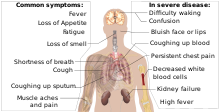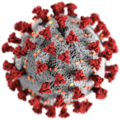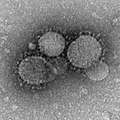Coronavirus diseases: Difference between revisions
mNo edit summary |
Diseases in other animals - from Coronavirus (there is more detail in that article) |
||
| Line 45: | Line 45: | ||
The [[severe acute respiratory syndrome coronavirus 2]] (SARS-CoV-2) causes [[coronavirus disease 2019]] (COVID-19), which in December 2019 led to a [[pneumonia]] outbreak in [[Wuhan]], [[China]], which developed into the [[COVID-19 pandemic]]. |
The [[severe acute respiratory syndrome coronavirus 2]] (SARS-CoV-2) causes [[coronavirus disease 2019]] (COVID-19), which in December 2019 led to a [[pneumonia]] outbreak in [[Wuhan]], [[China]], which developed into the [[COVID-19 pandemic]]. |
||
== Diseases in other animals == |
|||
Coronaviruses have been recognized as causing pathological conditions in [[veterinary medicine]] since the 1930s.<ref name=":3">{{Cite book| vauthors = McIntosh K |title=Current Topics in Microbiology and Immunology / Ergebnisse der Mikrobiologie und Immunitätsforschung|date=1974| veditors = Arber W, Haas R, Henle W, Hofschneider PH, Jerne NK, Koldovský P, Koprowski H, Maaløe O, Rott R |chapter=Coronaviruses: A Comparative Review|series=Current Topics in Microbiology and Immunology / Ergebnisse der Mikrobiologie und Immunitätsforschung|language=en|location=Berlin, Heidelberg |publisher=Springer |volume= |pages=87 |doi=10.1007/978-3-642-65775-7_3 |isbn=978-3-642-65775-7 }}</ref> They infect a range of animals such as swine, cattle, horses, camels, cats, dogs, rodents, birds, bats, and other wildlife.<ref name=":14">{{cite book |title=Fenner's Veterinary Virology |date=2017 |publisher=Academic Press |isbn=978-0-12-800946-8 |pages=435–461 |chapter-url=https://www.sciencedirect.com/science/article/pii/B9780128009468000246 |language=en |chapter=Chapter 24 - Coronaviridae|doi=10.1016/B978-0-12-800946-8.00024-6 |edition=Fifth }}</ref> The majority of animal related coronaviruses infect the [[Gastrointestinal tract|intestinal tract]] and are transmitted by a fecal-oral route.<ref>{{cite book | vauthors = Murphy FA, Gibbs EP, Horzinek MC, Studdart MJ |title=Veterinary Virology |publisher=Academic Press |location=Boston |year=1999|pages=495–508 |isbn=978-0-12-511340-3}}</ref> |
|||
==Gallery== |
==Gallery== |
||
Revision as of 05:15, 21 May 2020


A coronavirus disease (COVID /ˈkoʊvɪd, ˈkɒvɪd/),[2][3][4] coronavirus respiratory syndrome, coronavirus pneumonia, coronavirus flu, or any other variant, is a disease caused by members of the coronavirus (CoV) family.
Coronaviruses cause different coronavirus diseases including severe acute respiratory syndrome (SARS), Middle East respiratory syndrome (MERS),[5] and coronavirus disease 2019 (COVID-19).[6] Some strains of coronaviruses can also cause the common cold.[7][8][9][10]
The 2019–20 coronavirus outbreak, caused by COVID-19, was declared a pandemic by the World Health Organization (WHO) on 11 March 2020.[11] Local transmission of the disease has been recorded in many countries across all six WHO regions.[12] COVID-19 is caused by the SARS-CoV-2 coronavirus.[6] SARS-CoV-2 is the third zoonotic coronavirus, after SARS-CoV and MERS-CoV
Etymology
Corona is derived from Template:Lang-la, meaning "crown or garland", which was conferred among Romans as a reward for distinguished services.[13] Virus comes from Latin, meaning a “slimy liquid” or “poison.”[14]
Human coronavirus diseases
Coronavirus disease was first discovered in humans in the 1930s.[15] The virus, Human coronavirus 229E (HCoV-229E) was first isolated in 1965.[15] A further three coronaviridae were identified in humans, these being human coronavirus NL63 (HCoV-NL63), Human coronavirus OC43 (HCoV-OC43) and Human coronavirus HKU1 (HCoV-HKU1).[15] HCoV-229E and HCoV-NL63 are Alphacoronavirus (α-CoV or Alpha-CoV),[16] while HCoV-OC43, HCoV-HKU1, MERS-CoV, SARS-CoV are Betacoronavirus (β-CoV or Beta-CoV).[16]
In November 2002 an outbreak of Severe Acute Respiratory Syndrome (SARS) was discovered. This disease originated in China and subsequently spread to Vietnam, Hong Kong, Taiwan, Singapore and Canada.
A new coronavirus was identified in 2012 with a SARS like illness, called the Middle East Respiratory Syndrome (MERS) CoV resulted in a limited number of outbreaks, mostly in Saudi Arabia and other middle eastern countries.
In December 2019, a novel coronavirus (nCoV) was identified in Wuhan, China, which was isolated on 7 January 2020.[17] The World Health Organisation recommended the interim name of the disease as 2019-nCoV acute respiratory disease (2019-nCoV ARD) and 2019 novel coronavirus (2019-nCov) as the virus.[18] However, the disease has subsequently been reclassified as coronavirus disease 2019 (COVID-19) and the virus as severe acute respiratory syndrome coronavirus 2 (SARS-CoV-2),[19] which is closely related to the earlier SARS-CoV and genetically clusters within Betacoronavirus with subgenus Sarbecovirus.[20]
Zoonotic coronavirus diseases
| MERS-CoV | SARS-CoV | SARS-CoV-2 | |
|---|---|---|---|
| Disease | MERS | SARS | COVID-19 |
| Outbreaks | 2012 | 2002–2004 | 2019−present |
| Epidemiology | |||
| Date of first identified case |
June 2012 |
November 2002 |
December 2019[21] |
| Location of first identified case |
Jeddah, Saudi Arabia |
Shunde, China |
Wuhan, China |
| Age average | 56 | 44[22][a] | 56[23] |
| Sex ratio (M:F) | 3.3:1 | 0.8:1[24] | 1.6:1[23] |
| Confirmed cases | 2494 | 8096[25] | 676,609,955[26][b] |
| Deaths | 858 | 774[25] | 6,881,955[26][b] |
| Case fatality rate | 37% | 9.2% | 1.02%[26] |
| Symptoms | |||
| Fever | 98% | 99–100% | 87.9%[27] |
| Dry cough | 47% | 29–75% | 67.7%[27] |
| Dyspnea | 72% | 40–42% | 18.6%[27] |
| Diarrhea | 26% | 20–25% | 3.7%[27] |
| Sore throat | 21% | 13–25% | 13.9%[27] |
| Ventilatory use | 24.5%[28] | 14–20% | 4.1%[29] |
| Notes | |||
A zoonotic disease is an infectious disease caused by a pathogen (an infectious agent, such as a bacterium, virus, parasite or prion) that has jumped from an animal (usually a vertebrate) to a human.[30] SARS-CoV-2 is the third zoonotic coronavirus, after SARS-CoV and MERS-CoV,[31] although there is evidence that may support a zoonotic origin of HCoV-NL63 too.[32]
SARS
In 2003 severe acute respiratory syndrome coronavirus (SARS-CoV), causing severe acute respiratory syndrome (SARS), led to the 2002–2004 SARS outbreak. More than 8,000 people from 29 different countries and territories were infected, and at least 774 died.[33]
MERS
In 2012 Middle East respiratory syndrome-related coronavirus (MERS-CoV), causing Middle East respiratory syndrome (MERS), was identified.[34]
MERS-CoV is responsible for the 2012 MERS outbreak, primarily in the Middle East, the 2015 MERS outbreak in South Korea and the 2018 MERS outbreak primarily in Saudi Arabia.
COVID-19
The severe acute respiratory syndrome coronavirus 2 (SARS-CoV-2) causes coronavirus disease 2019 (COVID-19), which in December 2019 led to a pneumonia outbreak in Wuhan, China, which developed into the COVID-19 pandemic.
Diseases in other animals
Coronaviruses have been recognized as causing pathological conditions in veterinary medicine since the 1930s.[35] They infect a range of animals such as swine, cattle, horses, camels, cats, dogs, rodents, birds, bats, and other wildlife.[36] The majority of animal related coronaviruses infect the intestinal tract and are transmitted by a fecal-oral route.[37]
Gallery
-
Illustration of a SARS-CoV-2 virus which causes coronavirus disease 2019
-
Electron micrograph of SARS-CoV-2 with its visible coronae
-
Electron microscope image showing SARS-CoV-2 emerging from the surface of cells (blue/pink) cultured in the lab
-
MERS-CoV particles as seen by negative stain electron microscopy
-
Formation of Human coronavirus HKU1, a coronavirus causing symptoms of the common cold in humans[8][9]
See also
References
- ^ The diagram reflects symptoms given at Coronavirus disease 2019#Signs and symptoms. References are listed there.
- ^ BBC News (11 February 2020). "Coronavirus officially named Covid-19, says WHO". BBC.
- ^ World Health Organization (11 February 2020). "COVID-19: New coronavirus given name by World Health Organization". CanWest Global. Global News.
- ^ "Covid-19, n." Oxford English Dictionary. Retrieved 15 April 2020.
- ^ "Middle East respiratory syndrome coronavirus (MERS-CoV)". World Health Organization. June 2015. Retrieved 6 April 2020.
- ^ a b Lim, Yvonne Xinyi; Ng, Yan Ling; Tam, James P.; Liu, Ding Xiang (25 July 2016). "Human Coronaviruses: A Review of Virus–Host Interactions". Diseases. 4 (3): 26. doi:10.3390/diseases4030026. ISSN 2079-9721. PMC 5456285. PMID 28933406.
See Table 1.
{{cite journal}}: CS1 maint: unflagged free DOI (link) - ^ a b Fehr AR, Perlman S (2015). Maier HJ, Bickerton E, Britton P (eds.). "Coronaviruses: an overview of their replication and pathogenesis". Methods in Molecular Biology. 1282. Springer: 1–23. doi:10.1007/978-1-4939-2438-7_1. ISBN 978-1-4939-2438-7. PMC 4369385. PMID 25720466.
See section: Virion Structure.
- ^ Australian Government. "Colds". healthdirect Australia. Retrieved 18 April 2020.
{{cite web}}: CS1 maint: url-status (link) - ^ "WHO Director-General's opening remarks at the media briefing on COVID-19". World Health Organization (WHO) (Press release). 11 March 2020. Archived from the original on 11 March 2020. Retrieved 6 April 2020.
- ^ "WHO Situation Report #65" (PDF). WHO. 25 March 2020.
{{cite web}}: CS1 maint: url-status (link) - ^ TruthBeTold Ministry; Noah Webster (16 January 2018). Webster's Dictionary & World English Bible: Rainbow Missions. TruthBeTold Ministry. p. 1068. ISBN 978-82-339-1570-4.
- ^ "Virus". Encyclopædia Britannica. Retrieved 18 May 2020.
- ^ a b c "COVID-19/SARS-CoV-2 Pandemic". Faculty of Pharmaceutical Medicine. 6 April 2020. Retrieved 18 May 2020.
- ^ a b "Human Coronavirus Types". Centers for Disease Control and Prevention . 15 February 2020. Retrieved 18 May 2020.
- ^ "Novel Coronavirus – China". World Health Organisation. 12 January 2020. Retrieved 18 May 2020.
- ^ "Novel Coronavirus(2019-nCoV)" (PDF). World Health Organisation. 30 January 2020. Retrieved 18 May 2020.
- ^ "Naming the coronavirus disease (COVID-19) and the virus that causes it". World Health Organisation. Retrieved 18 May 2020.
- ^ "Disease background of COVID-19". European Centre for Disease Prevention and Control. 8 May 2020. Retrieved 18 May 2020.
- ^ Wang C, Horby PW, Hayden FG, Gao GF (February 2020). "A novel coronavirus outbreak of global health concern". Lancet. 395 (10223): 470–473. doi:10.1016/S0140-6736(20)30185-9. PMC 7135038. PMID 31986257.
- ^ Lau EH, Hsiung CA, Cowling BJ, Chen CH, Ho LM, Tsang T, Chang CW, Donnelly CA, Leung GM (March 2010). "A comparative epidemiologic analysis of SARS in Hong Kong, Beijing and Taiwan". BMC Infectious Diseases. 10: 50. doi:10.1186/1471-2334-10-50. PMC 2846944. PMID 20205928.
- ^ a b "Old age, sepsis tied to poor COVID-19 outcomes, death". CIDRAP, University of Minnesota. 10 March 2020. Retrieved 29 March 2020.
- ^ Karlberg J, Chong DS, Lai WY (February 2004). "Do men have a higher case fatality rate of severe acute respiratory syndrome than women do?". American Journal of Epidemiology. 159 (3): 229–31. doi:10.1093/aje/kwh056. PMC 7110237. PMID 14742282.
- ^ a b "Summary of probable SARS cases with onset of illness from 1 November 2002 to 31 July 2003". World Health Organization. April 2004.
- ^ a b c "COVID-19 Dashboard by the Center for Systems Science and Engineering (CSSE) at Johns Hopkins University (JHU)". ArcGIS. Johns Hopkins University. Retrieved 10 March 2023.
- ^ a b c d e "Report of the WHO-China Joint Mission on Coronavirus Disease 2019 (COVID-19)" (PDF). World Health Organization. February 2020.
- ^ Oh MD, Park WB, Park SW, Choe PG, Bang JH, Song KH, Kim ES, Kim HB, Kim NJ (March 2018). "Middle East respiratory syndrome: what we learned from the 2015 outbreak in the Republic of Korea". The Korean Journal of Internal Medicine. 33 (2): 233–246. doi:10.3904/kjim.2018.031. PMC 5840604. PMID 29506344.
- ^ Ñamendys-Silva SA (March 2020). "Respiratory support for patients with COVID-19 infection". The Lancet. Respiratory Medicine. 8 (4): e18. doi:10.1016/S2213-2600(20)30110-7. PMC 7129706. PMID 32145829.
- ^ WHO. "Zoonoses". Archived from the original on 3 January 2015. Retrieved 18 December 2014.
- ^ "COVID-19: a novel zoonotic disease caused by a coronavirus from China: what we know and what we don't". National Center for Biotechnology Information. 17 March 2020. Retrieved 30 April 2020.
- ^ "Evidence Supporting a Zoonotic Origin of Human Coronavirus Strain NL63". American Society for Microbiology. December 2012. Retrieved 19 May 2020.
- ^ "How SARS terrified the world in 2003, infecting more than 8,000 people and killing 774". businessinsider.com. 21 February 2020. Retrieved 6 April 2020.
- ^ Doucleef, Michaeleen (26 September 2012). "Scientists Go Deep On Genes Of SARS-Like Virus". Associated Press. Archived from the original on 27 September 2012. Retrieved 6 April 2020.
{{cite news}}: Unknown parameter|name-list-format=ignored (|name-list-style=suggested) (help) - ^ McIntosh K (1974). "Coronaviruses: A Comparative Review". In Arber W, Haas R, Henle W, Hofschneider PH, Jerne NK, Koldovský P, Koprowski H, Maaløe O, Rott R (eds.). Current Topics in Microbiology and Immunology / Ergebnisse der Mikrobiologie und Immunitätsforschung. Current Topics in Microbiology and Immunology / Ergebnisse der Mikrobiologie und Immunitätsforschung. Berlin, Heidelberg: Springer. p. 87. doi:10.1007/978-3-642-65775-7_3. ISBN 978-3-642-65775-7.
- ^ "Chapter 24 - Coronaviridae". Fenner's Veterinary Virology (Fifth ed.). Academic Press. 2017. pp. 435–461. doi:10.1016/B978-0-12-800946-8.00024-6. ISBN 978-0-12-800946-8.
- ^ Murphy FA, Gibbs EP, Horzinek MC, Studdart MJ (1999). Veterinary Virology. Boston: Academic Press. pp. 495–508. ISBN 978-0-12-511340-3.
External links
![]() The dictionary definition of COVID at Wiktionary
The dictionary definition of COVID at Wiktionary





![Formation of Human coronavirus HKU1, a coronavirus causing symptoms of the common cold in humans[8][9]](http://upload.wikimedia.org/wikipedia/commons/thumb/8/8a/Coronavirus-HKU1.png/120px-Coronavirus-HKU1.png)